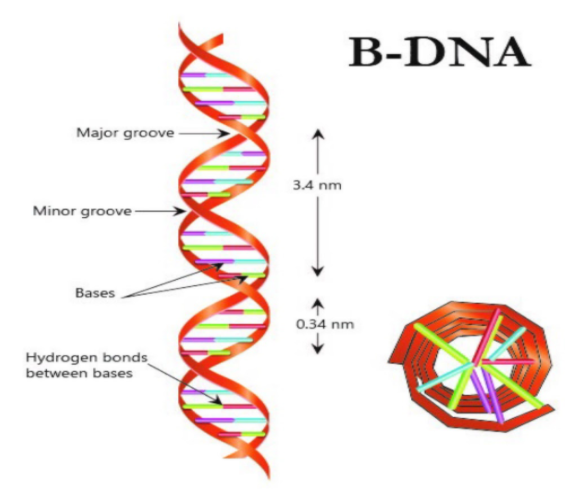
How far is each base pair from the next one in the DNA double helix model?
(A)2 nm
(B)3.4 nm
(C)34nm
(D)0.34 nm
Answer
562.8k+ views
Hint: Each base pair from the next one in the DNA double helix model is 3.4 Angstrom apart. The Å unit can be easily converted to a nanometer as you all know that 1 Å is equal to 0.1 nm.
Complete answer:
Each base pair from the next one in the DNA double helix model is 0.34 nm apart. ‘bp’ is defined as the base pair(s). The single base pair comes out to be approximately 3.4 Å of length along the strand, and roughly 618 or 643 daltons for DNA and RNA respectively.
Additional Information: A nucleotide, if specifically considered, the 'base pair' is a basic unit of double-stranded nucleic acids consisting of two nucleobases sure to one another by hydrogen bonds. They form the building blocks of the DNA helix and contribute to the folded structure of both DNA and RNA. The bases are joined by the specific hydrogen bonding patterns, "Watson–Crick" base pairs (guanine-cytosine and adenine–thymine) allow the DNA helix to take care of a daily helical structure that's subtly hooked into its nucleotide sequence. This based-paired structure helps in providing a redundant copy of the genetic information encoded within each strand of DNA. The regular structure which was due to the DNA helix makes DNA compatible with the storage of genetic information, while base-pairing between DNA and incoming nucleotides provides the mechanism through which DNA polymerase replicates the molecule of DNA and RNA polymerase transcribes DNA into the RNA. It was seen that many DNA-binding proteins can recognize specific base-pairing patterns that help to identify particular regulatory regions of genes.
So, the correct answer is ‘0.34 nm’.
Note: The DNA molecule was first observed by a German biochemist named Frederich Miescher in 1869. But for a few years, researchers didn't realize the importance of this molecule. It was after the year 1953 that Watson, Crick, Wilkins, and Rosalind Franklin found out the structure of DNA, a double helix which they realized could carry biological information.

Complete answer:
Each base pair from the next one in the DNA double helix model is 0.34 nm apart. ‘bp’ is defined as the base pair(s). The single base pair comes out to be approximately 3.4 Å of length along the strand, and roughly 618 or 643 daltons for DNA and RNA respectively.
Additional Information: A nucleotide, if specifically considered, the 'base pair' is a basic unit of double-stranded nucleic acids consisting of two nucleobases sure to one another by hydrogen bonds. They form the building blocks of the DNA helix and contribute to the folded structure of both DNA and RNA. The bases are joined by the specific hydrogen bonding patterns, "Watson–Crick" base pairs (guanine-cytosine and adenine–thymine) allow the DNA helix to take care of a daily helical structure that's subtly hooked into its nucleotide sequence. This based-paired structure helps in providing a redundant copy of the genetic information encoded within each strand of DNA. The regular structure which was due to the DNA helix makes DNA compatible with the storage of genetic information, while base-pairing between DNA and incoming nucleotides provides the mechanism through which DNA polymerase replicates the molecule of DNA and RNA polymerase transcribes DNA into the RNA. It was seen that many DNA-binding proteins can recognize specific base-pairing patterns that help to identify particular regulatory regions of genes.
So, the correct answer is ‘0.34 nm’.
Note: The DNA molecule was first observed by a German biochemist named Frederich Miescher in 1869. But for a few years, researchers didn't realize the importance of this molecule. It was after the year 1953 that Watson, Crick, Wilkins, and Rosalind Franklin found out the structure of DNA, a double helix which they realized could carry biological information.

Recently Updated Pages
A man running at a speed 5 ms is viewed in the side class 12 physics CBSE

State and explain Hardy Weinbergs Principle class 12 biology CBSE

Which of the following statements is wrong a Amnion class 12 biology CBSE

Two Planoconcave lenses 1 and 2 of glass of refractive class 12 physics CBSE

The compound 2 methyl 2 butene on reaction with NaIO4 class 12 chemistry CBSE

Bacterial cell wall is made up of A Cellulose B Hemicellulose class 12 biology CBSE

Trending doubts
What are the major means of transport Explain each class 12 social science CBSE

Which are the Top 10 Largest Countries of the World?

Draw a labelled sketch of the human eye class 12 physics CBSE

Explain sex determination in humans with line diag class 12 biology CBSE

The pH of the pancreatic juice is A 64 B 86 C 120 D class 12 biology CBSE

Give 10 examples of unisexual and bisexual flowers




